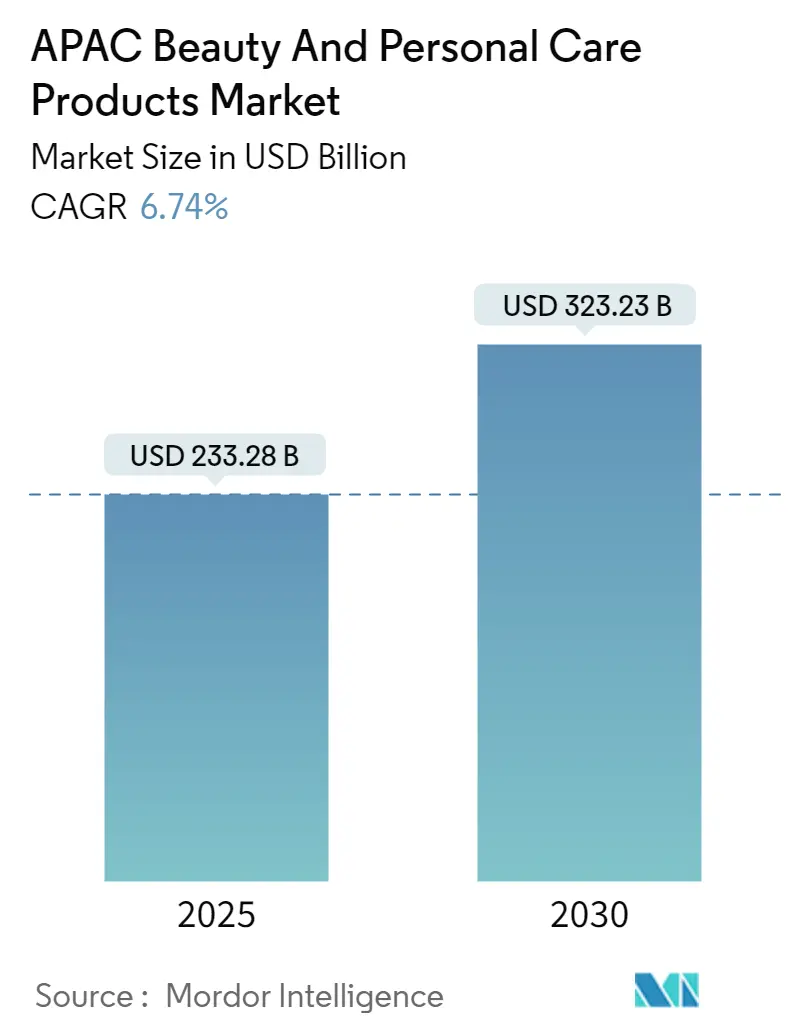
| Study Period | 2019 - 2030 |
| Base Year For Estimation | 2024 |
| Forecast Data Period | 2025 - 2030 |
| Market Size (2025) | USD 233.28 Billion |
| Market Size (2030) | USD 323.23 Billion |
| CAGR (2025 - 2030) | 6.74 % |
| Market Concentration | Low |
Major Players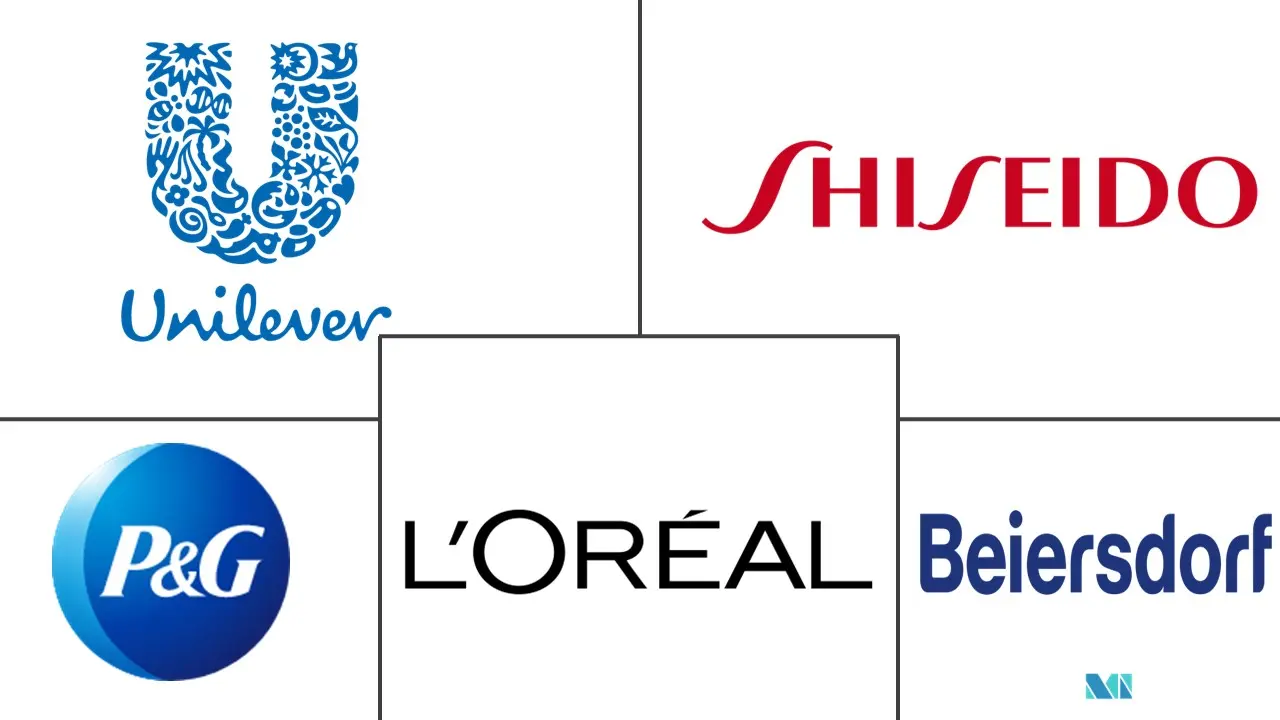
*Disclaimer: Major Players sorted in no particular order |
APAC Beauty & Personal Care Products Market Analysis
The APAC Beauty And Personal Care Products Market size is estimated at USD 233.28 billion in 2025, and is expected to reach USD 323.23 billion by 2030, at a CAGR of 6.74% during the forecast period (2025-2030).
In Asia-Pacific, consumers have increased spending on personal hygiene, which has led to the escalated sales of shower gel, sanitizers, hand washes, etc. On the other hand, the e-commerce trend is boosting the sales of beauty and personal care products through online channels. Hence, players are turning their heads toward online channels. For instance, in 2021, Hindustan Unilever Ltd (HUL) announced its plans to scale up the online reach of the company's premium brands through standalone branded sites, as well as its multi-brand shopping platform UShop, wherein UShop (launched in the second half of 2020) is set to expand beyond the National Capital Region and Mumbai to eight more cities across the country.
Consumers across the region are inclined toward organic beauty and personal care products, especially those formulated using Ayurvedic, botanical, and herbal ingredients, which are expected to drive market growth during the study period. The rising awareness about the harmful effects of chemicals and synthetic products is another factor augmenting the growth of the market. Moreover, the rising premiumization and the consumers' need for more targeted solutions are accelerating the growth of personalized/customized beauty and personal care products. Furthermore, major players are intensely embarking on product innovation and mergers and acquisitions as their prime strategy to consolidate the market studied. For instance, in 2021, Kao Corporation, through its subsidiary Kao Salon Japan, launched its prestige hair salon brand, Oribe, in Japan. The brand consists of 23 product line-ups that were made widely available in Japan.
APAC Beauty & Personal Care Products Market Trends
Demand For Hair Care Products That Target Specific Issues
The hair care segment dominates the Asia-Pacific personal care products market. The demand for hair care and skin care is increasing in both rural and urban markets, leading to rising opportunities throughout the region. Consumers in urban areas spend three times as much on hair care and skin care products as compared to those in rural areas, providing significant scope for multiple brands to grow in the hinterlands. However, with the growing influence of media and television, rural consumers have been showcasing significant demand for hair coloring products, among others, which are often purchased in the sachet format in these areas. Amid the growing prevalence of hair thinning, loss of volume, dryness, and several other hair-related concerns among consumers, the hair care products that target these specific concerns are emerging as the most affluent and cost-effective ways to maintain hair health at home.
Furthermore, hair care product manufacturers have been heavily investing in research and development to experiment with new and improvised product formulations in shampoos, conditioners, hair tonics, serums, oils, and creams, which are gentle on the scalp and have regenerated properties to ensure faster hair growth and thicker volume. For instance, in January 2021, Emmbros Overseas, one of the fastest-growing Indian companies in the Beauty and HPC (Health and Personal Care) segment, introduced its premium hair care range titled the 'GO range' via St. Botanica. The range encompasses cruelty-free vegan shampoos, oils, serums, masks, and conditioners for specific hair requirements and concerns, including hair breakage, brittleness, fizziness, dandruff, hair fall, and sweat control, and is suitable for all hair types.
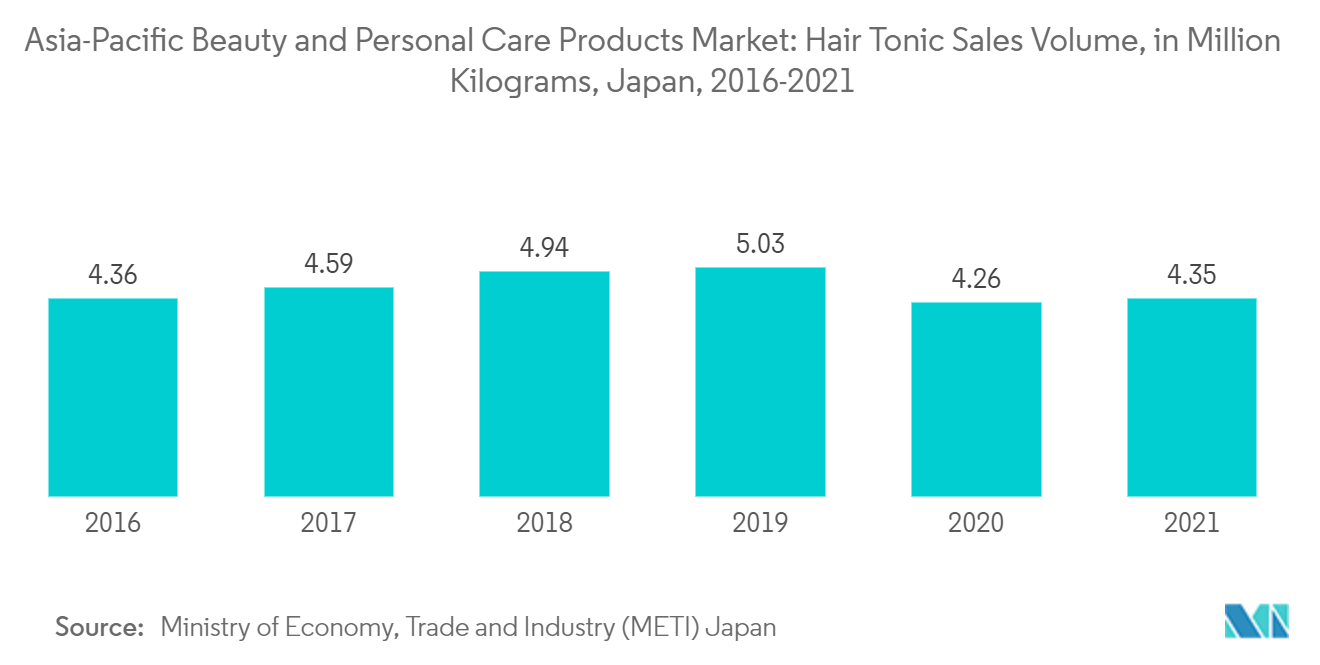
China Holds the Largest Share
The increasing awareness about a healthier lifestyle among individuals for healthy and hygienic living has contributed to the increase in per capita expenditure on household products (including personal care products) across China. As per the National Bureau of Statistics of China, the per capita expenditure on household products (including personal care products) across China increased to USD 3,781.2 in 2021, a nominal increase of 13.6% over the previous year. China is one of the world's hotspots and fastest-changing beauty markets, introducing industry-leading innovations and setting trends globally. Products with claims such as UV protection, long-lasting, moisturizing/hydrating, botanical/herbal, whitening, and anti-aging, account for a considerable number of product launches. Haircare products with specific functions such as anti-greying and anti-hair fall are witnessing significant growth, owing to the high adoption rate among the millennials and Gen-Z population. Brands are also coming up with customized approaches to cater to the growing demand. For instance, in May 2021, L'Oréal Paris launched an omnichannel concept store in collaboration with AKQA in Shanghai, offering visitors a personalized experience and cultivating a better relationship with customers.
Moreover, with the growing demand for premium cosmetic products such as K-Beauty and C-Beauty in the country, players operating in the market are focusing on expanding their product portfolio to achieve significant market shares. For instance, in October 2021, Sephora China released more than 240 new beauty products from 51 brands, revealing the newness of 7 C-beauty brands and the domestic debut of five overseas niche brands. For the first time, Sephora launched its C-Beauty showroom to show the emerging power of premium local beauty brands, including exclusive makeup brands MAOGEPINGLIGHT and COLOR STUDIO BY MARIE DALGAR, together with the debut of luxury art beauty brand YUMEE, which brought more possibilities of beauty within Eastern narratives.
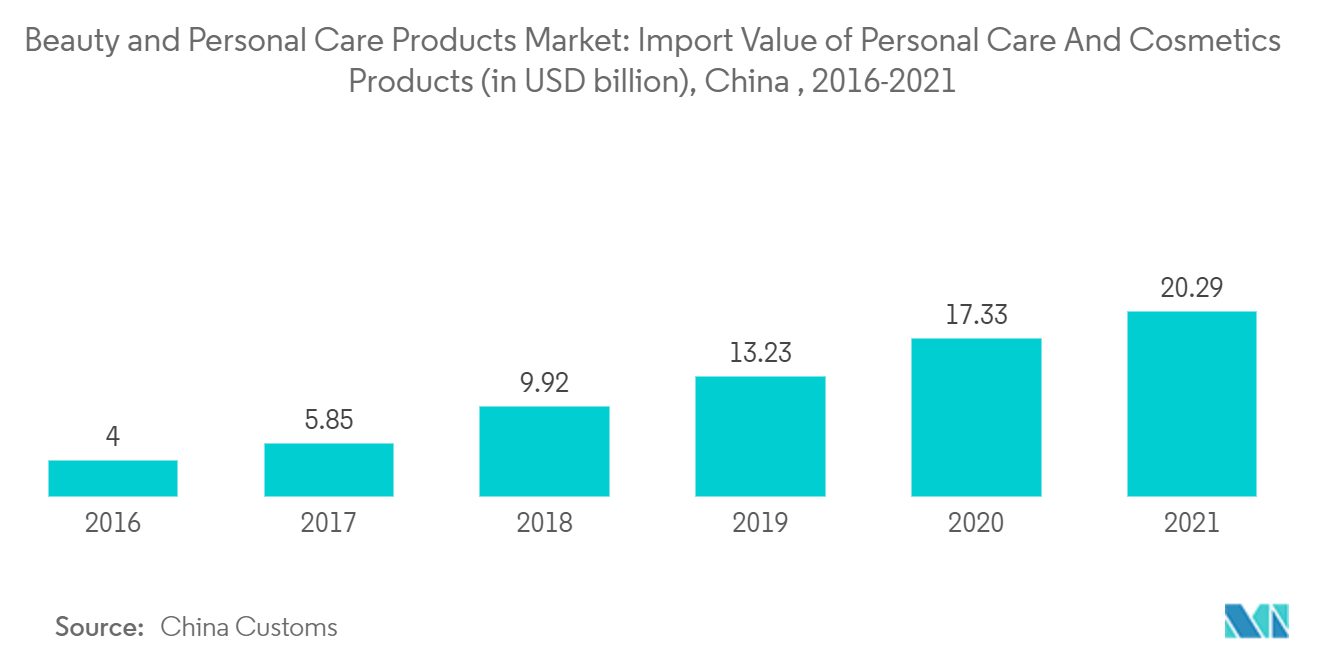
APAC Beauty & Personal Care Products Industry Overview
Some of the key players in the beauty and personal care products market in Asia-Pacific include Unilever PLC, Revlon Inc., Shiseido Co. Ltd, Beiersdorf AG, L'Oreal Group, Procter & Gamble, and The Estée Lauder Companies Inc. L'Oréal SA is one of the most active companies, with numerous brand offerings and a broad range of beauty and skincare products across the region. The company has spent considerably on improving quality and product innovation in terms of ingredients, functionality, and packaging as its key strategy to increase its geographical presence and customer base. Additionally, companies are innovating their products and advertising advanced and niche categories, which can eliminate recurring problems faced by consumers due to pollution, aging, and lack of time for care.
APAC Beauty & Personal Care Products Market Leaders
-
The Procter & Gamble Company
-
Unilever PLC
-
L'Oréal S.A.
-
Shiseido Company, Limited
-
Beiersdorf AG
- *Disclaimer: Major Players sorted in no particular order
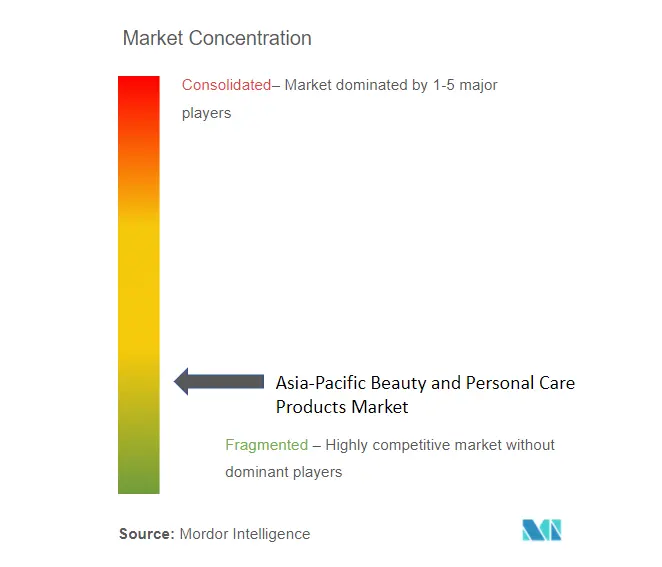
APAC Beauty & Personal Care Products Market News
- June 2022: The Shiseido Group launched a new skincare brand, SIDEKICK, designed to address skin concerns specific to Gen Z men in Asia. The brand offers five types of face washes, a moisturizer, and a sheet mask.
- February 2022: Shiseido Company Limited released Perfect Cover Foundation MC*1 and Perfect Cover Foundation VC*2, which cover various skin discolorations, and are exclusive products from the PERFECT COVER brand of Shiseido Life Quality Makeup. The Perfect Cover series (four products, ten items) has been released in Japan.
- August 2021: Colgate launched its recyclable toothpaste tube in India. The recyclable tubes will first be used to manufacture Colgate's Active Salt and Vedshakti toothpaste and will subsequently be rolled out for other brands.
APAC Beauty & Personal Care Products Industry Segmentation
Beauty and personal care products are consumer products used for personal hygiene and skin and hair beautification. The Asia-Pacific beauty and personal care products market is segmented by product type, category, distribution channel, and geography. By product type, the market studied is segmented into personal care products and cosmetic/make-up products. The personal care products segment is further segmented into hair care products, skincare products, bath and shower products, oral care products, men's grooming products, and deodorants and antiperspirants. By cosmetics/make-up products, the market is segmented into facial care products, eye cosmetic products, and lip and nail make-up products. By category, the market studied is segmented into premium and mass products. By distribution channel, the market studied is segmented into supermarkets/hypermarkets, convenience stores, specialty stores, online retail stores, and other distribution channels. By geography, the market is segmented into Japan, China, India, Australia, and the Rest of Asia-Pacific. For each segment, the market sizing and forecasts have been done on the basis of value in USD million.
| By Product Type | Personal Care Products | Hair Care Products | Shampoo | |
| Conditioners | ||||
| Hair Oil | ||||
| Hair Styling and Coloring Products | ||||
| Other Hair Care Products | ||||
| Skin Care Products | Facial Care Products | |||
| Body Care Products | ||||
| Lip Care Products | ||||
| Bath and Shower | Shower Gels | |||
| Soaps | ||||
| Bath Salts | ||||
| Other Bath and Shower Products | ||||
| Oral Care | Toothbrushes and Replacements | |||
| Toothpaste | ||||
| Mouthwashes and Rinses | ||||
| Other Oral Care Products | ||||
| Men's Grooming Products | ||||
| Deodorants and Antiperspirants | ||||
| Cosmetics/Make-up Products | Facial Care Products | |||
| Eye Cosmetic Products | ||||
| Lip and Nail Make-up Products | ||||
| By Category | Mass Products | |||
| Premium Products | ||||
| By Distribution Channel | Supermarkets/Hypermarkets | |||
| Convenience Stores | ||||
| Specialty Stores | ||||
| Online Retail Stores | ||||
| Other Distribution Channels | ||||
| By Geography | India | |||
| China | ||||
| Japan | ||||
| Australia | ||||
| Rest of Asia-Pacific | ||||
APAC Beauty & Personal Care Products Market Research FAQs
How big is the APAC Beauty and Personal Care Products Market?
The APAC Beauty and Personal Care Products Market size is expected to reach USD 233.28 billion in 2025 and grow at a CAGR of 6.74% to reach USD 323.23 billion by 2030.
What is the current APAC Beauty and Personal Care Products Market size?
In 2025, the APAC Beauty and Personal Care Products Market size is expected to reach USD 233.28 billion.
Who are the key players in APAC Beauty and Personal Care Products Market?
The Procter & Gamble Company, Unilever PLC, L'Oréal S.A., Shiseido Company, Limited and Beiersdorf AG are the major companies operating in the APAC Beauty and Personal Care Products Market.
What years does this APAC Beauty and Personal Care Products Market cover, and what was the market size in 2024?
In 2024, the APAC Beauty and Personal Care Products Market size was estimated at USD 217.56 billion. The report covers the APAC Beauty and Personal Care Products Market historical market size for years: 2019, 2020, 2021, 2022, 2023 and 2024. The report also forecasts the APAC Beauty and Personal Care Products Market size for years: 2025, 2026, 2027, 2028, 2029 and 2030.
Our Best Selling Reports
APAC Beauty & Personal Care Products Industry Report
The APAC Beauty & Personal Care Products market is a dynamic and rapidly evolving sector. The market is segmented by product type, including personal care products and cosmetics/make-up products. It is further categorized into mass products and premium products. Distribution channels for these products include supermarkets/hypermarkets, convenience stores, specialty stores, online retail stores, and other distribution channels. The geographical segmentation covers India, China, Japan, Australia, and the rest of Asia-Pacific.
The market size and industry analysis indicate significant growth potential in the region. The industry overview and industry statistics highlight the increasing demand for beauty and personal care products. Industry trends suggest a shift towards premium products and online retail channels. Market segmentation reveals diverse consumer preferences across different regions.
The industry research and market analysis provide insights into the market share and industry growth. The market outlook and market report suggest a positive trend in the coming years. The report offers a comprehensive market forecast and market review, highlighting the market value and market growth potential.
The industry reports and report example provide detailed market data and market predictions. The industry size and industry sales data are crucial for understanding the market leaders and market overview. The industry information and industry outlook are essential for making informed business decisions.
The report pdf and research companies offer valuable insights into the market trends and market forecast. The market segmentation and market value data are critical for understanding the target market. The report summary provides a clear and concise overview of the market, making it easy to understand the key industry trends and market outlook.




